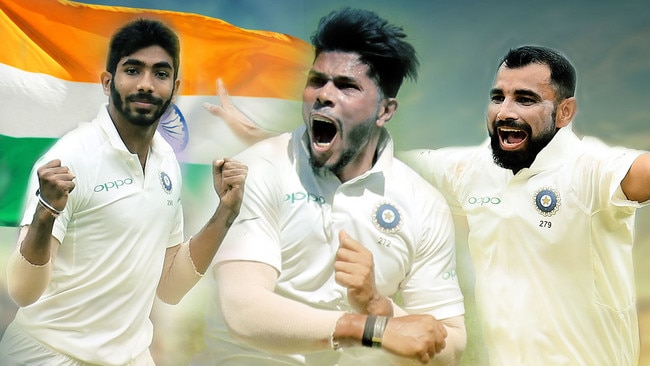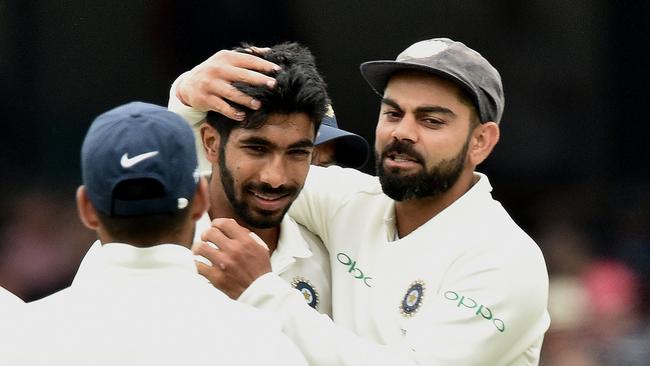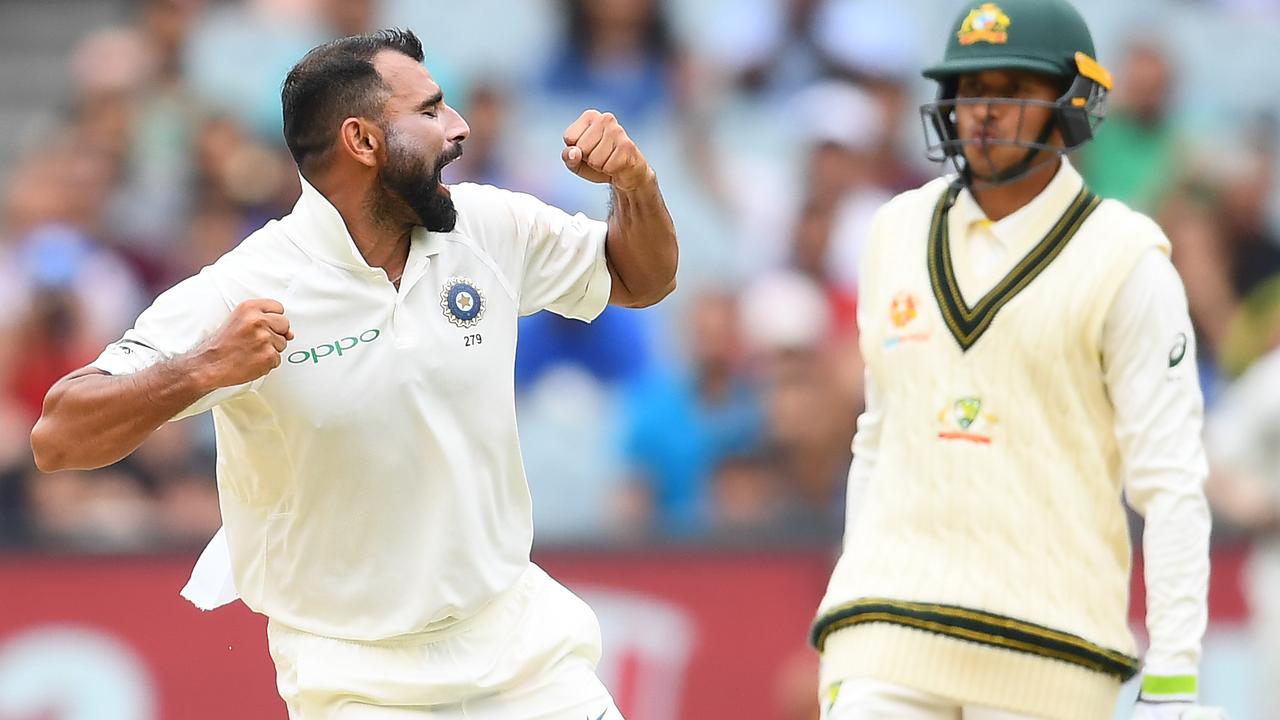Australia v India Test series: Pat Cummins, Jasprit Bumrah and why pace bowling is the key to victory
The job of an Indian fast bowler has evolved from ‘get the ball old for the spinners’ to ‘get it done like the Aussies’. The battle of the quicks shapes as potentially the most decisive one this summer.

Cricket
Don't miss out on the headlines from Cricket. Followed categories will be added to My News.
Dennis Lillee took one look at Sachin Tendulkar and ruled a line through his name.
In 1987 a 14-year-old Tendulkar boarded a train from Mumbai to Chennai and chanced his right arm at the opening of the MRF Pace Foundation.
“I always liked pace bowling. I like watching fast bowlers,” Tendulkar once said.
As Lillee pruned hundreds of hopefuls into an inaugural intake of about eight Indian quicks, Tendulkar grabbed his bat and pads and – instead of returning home – faced up to the talented teens.
Tendulkar’s bowling career died that day in what proved to be a blessing masquerading as disappointment, and India’s eventual boom of fast bowlers was born.
Watch the 2020/21 Marsh Sheffield Shield LIVE on Kayo. New to Kayo? Get your free trial now & start streaming instantly >
The powerhouse nation has always had the batsmen and always had the spinners, but its recent ability to beat anyone - anywhere - is in large part because it finally has a world class stock of quicks.

“There was generally one really good paceman in every tour – Kapil Dev to big (Javagal) Srinath to Zaheer Khan, who was a beauty,” former Test bowler Damien Fleming told News Corp.
“Whereas now we’re talking batteries. In that 2018-19 series (when India beat Australia in a series Down Under for the first time) our bowling attack was as good as it can get. But I thought at times they were faster and bouncier.
“They bowl a bit like the Australians. They do own that avenue of apprehension. They just cramp batsmen for room. They dry up their scoring options, and that’s what great attacks do.”
India’s cartel has gone from lone ranger to logjam and Jasprit Bumrah, Mohammad Shami, Umesh Yadav and young guns Navdeep Saini and Mohammed Siraj will jet into Sydney this week ready to wreak havoc in Australia.
Bumrah doesn’t know anything else. He is yet to play a home Test, taking 68 wickets at 20 after tours of South Africa, England, Australia and West Indies.
“Years ago Pakistan had all the fast bowlers bowling 150s – (Wasim) Akram and (Shoaib) Akhtar and back to Imran Khan,” Fleming said.
“India had the odd one like Srinath in the 140s, but were more 130s.
“It was sort of like, ‘Well that’s the way it is’.”
India’s recent plunge in depth isn’t all down to that 33-year-old academy, which has been directed by Glenn McGrath since 2012.
Adam Gilchrist reckons it is the chief reason, but Fleming highlighted two other factors.
“Even in my career they were starting to change their first-class wickets to have a bit more pace and bounce so they could actually perform better away from India,” he said.

“Then there’s the IPL. Talking and playing with fast bowlers from around the world and having fast bowling coaches from around the world, has it changed their training, their diet and their sport science?
“I think it has. I think it’s a combination of those three things.”
Below the eight esteemed head coaches in this year’s IPL sit fast bowling coaches Ryan Harris (Delhi), Shane Bond (Mumbai), and Adam Griffith (RCB).
It is a melting pot of global intelligence, which accelerates about 130 domestic Indians for eight pulsating weeks every year.
Bumrah is the bees knees right now, shaping as the biggest threat to Australia’s rock-solid top order seven years after he was discovered by Mumbai Indians.
Bumrah launched his career when, as a teenager, he snared 3-32 on debut, starting with the wicket of Virat Kohli.
The 26-year-old catches the eye with that off-putting action and keeps it with bags and bags of wickets.
“He’s almost like the first-generational Test fast-bowling star that brings T20 varieties to the Test arena,” Fleming said.
“The thing the Australians have prided ourselves on for years is to intimidate the opposition’s tail.
“With Bumrah and Shami they’ve certainly got that ability.”
Bumrah’s story is a wholesome one.
He lost his father at five and grew up with one pair of shoes and one T-shirt, washing them every day, and dreaming about one day affording a pair of Nikes.
That toe-crushing yorker was sculpted as a 12-year-old, when Bumrah realised that if he aimed at the floor skirting inside the house he could bowl for longer, because the quieter sounds wouldn’t disturb his mother Daljit’s naps.
“He’s got 68 (Test) wickets at 20 and an unorthodox, stuttery run-up, so I don’t think batsmen get a real sighter with him,” Fleming said.
“When bowlers like Brett Lee and Shoaib Akhtar come off long runs you’re expecting it quick.
“Whereas Bumrah has that weird run-up and unique action – the non-bowling arm going out to gully.”
Kohli rates Bumrah as the world’s most skilful bowler, taking pride in rarely losing his wicket in the nets.
Bumrah is the ace in a growing pack, and India’s answer to Aussie golden boy Patrick Cummins.
But Fleming warned the tourists had been blunted by injuries to swing bowler Bhuvneshwar Kumar (thigh) and the ever-ripening Ishant Sharma, 32, (abdominal muscle), who is unlikely to recover in time.
“Ishant’s last two years, he’s older but he’s one of the more improved paceman going around,” Fleming said.
“He bowls in-swingers generally, and we’ve got a lot of lefties, so he’s going a miss for them.
“Straight away I don’t think it’s quite as good as the attack two years ago, but Bumrah might be slightly better.
“Their biggest concern is what they do with their third seamer.
“(Umesh) Yadav’s got 144 Test wickets, but he’d need to be right at his best.
“Then you’ve got these two younger bowlers – Navdeep Saini and Mohammed Siraj. One of them might be the X-factor with their pure pace. Not many attacks have got their back-up bowlers as 150 (km) bowlers.”
For Bumrah’s band the challenge will largely be a fresh one, at least with a red ball.
Steve Smith and David Warner were suspended two years ago, while Marnus Labuschagne was a mere mortal when Shami got him for 38 at the SCG.
Perhaps they should speak to Cummins. Bizarrely, Cummins is the only player on the planet to thump four sixes off a Bumrah over in a T20.
Labuschagne scored back-to-back Sheffield Shield centuries last month and onlooker Fleming said he had risen to another level.
“He bats the way the great batsmen bat. They just seem to be in control,” Fleming said.
“Like Smithy in the Ashes, the opposition lose hope because he’s in so much control. He’s hungry. He wants to score big.
“We know Warner will get runs in Australia, but Marnus might score as many as Smith.
“And they’ve got a bro-mance, and what I’ve learnt from cricketing bro-mances – like (Matthew) Hayden and (Justin) Langer – you know what they like doing? Batting together.
“We’ve got three massive ins, but Labuschagne might be as big as any of them.”
Cummins’ crew knows what to expect.
King Kohli is world cricket’s biggest rock star and Cheteshwar Pujara faced a staggering 1208 deliveries in the last series, putting Donald Trump’s wall to shame.
No other player faced over 685.
Cummins has 4-66 in Tests against Kohli and captain Tim Paine seemed to toss him the ball every time the energetic captain strutted out.
“That new ball is really important for the Australians – get Pujara and Kohli in as early as possible,” Fleming said.
“Everyone’s vulnerable to a swinging or seaming delivery.
“You can’t think Pujara can bat as well as he did two years ago. That was a blueprint for Test match batting. I’d always be trying to rush him because he likes to wait for the ball to come to him.
“The main thing is not to get frustrated, and if he does get set then get funky with his fields.
“He reminds me a lot of VVS Laxman, beautiful timer. When he wants a single he generally bunts it into leg-side, so maybe we can have some catches in those positions so he takes a risk when he wants to bunt.”
With new-ball aces Mitchell Starc and Josh Hazlewood it is a stable seam trio for Australia, seemingly with several summers ahead.
Cummins is only 27, Hazlewood is 29 and Starc is 30. James Pattinson, 30, is often left to carry the drinks despite his habit of unsettling the very best batsmen.
It was Pattinson who dismissed Kane Williamson for nine and a duck in last year’s Boxing Day Test.
Some Aussie quicks could be forgiven for feeling a little bit like Stuart MacGill, who played most of his career outside of the Test XI and in Shane Warne’s shadow.
“It is tough for the young quicks getting a game with the big four there,” Fleming said.
“These are three of the greatest fast bowlers we’ve ever produced.
MORE CRICKET NEWS
Top 10: Two pacemen Tommo rates more than Lillee
The reason we’ve entered a new golden age of quicks
The 23 best Aussie cricketers under 23 years old
He’s ready: Selectors set to make big Pucovski call
“We’ve just happened to produce them at the same time, and they’re young enough to still play a lot of cricket.
“But if someone does breakthrough they’re going to be well-placed with that bowling group there. Jhye Richardson was so impressive on debut. He’s shorter and bowls a genuine swing.
“The one most likely to get a chance is Cameron Green – his bowling has enormous potential.
“He’s so tall and he bowls genuine outswing. I saw his bowling coach said they’re getting him to run in a bit slower, so he’s more stable when he takes off.
“The problem was his right arm was gathering across himself, so he had a bit of a mixed action.
“But I had a look on the weekend and now he’s fixed that up. The action looks pretty good.”
With India’s fast bowler job description evolving from ‘get the ball old for the spinners’ to ‘get it done like the Aussies’ it sets up a hot series.
Long steeped in spin and short on seam, the historical imbalance has shifted in Kohli’s camp and now mimics the Aussie enforcers.
“When you look at the two pace attacks it’s really hard not to get excited – unless you’re batting against them,” Fleming said.
Originally published as Australia v India Test series: Pat Cummins, Jasprit Bumrah and why pace bowling is the key to victory


